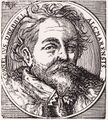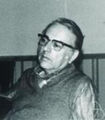Template:Selected anniversaries/December 5: Difference between revisions
No edit summary |
No edit summary |
||
| Line 70: | Line 70: | ||
||1949: Alfred James Lotka dies ... mathematician, physical chemist, and statistician, famous for his work in population dynamics and energetics. An American biophysicist, Lotka is best known for his proposal of the predator–prey model, developed simultaneously but independently of Vito Volterra. The Lotka–Volterra model is still the basis of many models used in the analysis of population dynamics in ecology. Pic. | ||1949: Alfred James Lotka dies ... mathematician, physical chemist, and statistician, famous for his work in population dynamics and energetics. An American biophysicist, Lotka is best known for his proposal of the predator–prey model, developed simultaneously but independently of Vito Volterra. The Lotka–Volterra model is still the basis of many models used in the analysis of population dynamics in ecology. Pic. | ||
||1953: William Sterling Parsons | File:Rear Admiral Deak Parsons.jpg|link=William Sterling Parsons (nonfiction)|1953: [[William Sterling Parsons (nonfiction)|American naval officer William Sterling "Deak" Parsons]] dues. Parsons served as an ordnance expert on the Manhattan Project during World War II. | ||
||1955: Glenn L. Martin dies ... pilot and businessman, founded the Glenn L. Martin Company. Pic. | ||1955: Glenn L. Martin dies ... pilot and businessman, founded the Glenn L. Martin Company. Pic. | ||
Revision as of 18:40, 26 November 2021
1601: After weeks at of hunting at sea, submarine inventor Cornelius Drebbel locates the marine cryptid and alleged supervillain Neptune Slaughter. The resulting battle will permanently drive Neptune Slaughter from Dutch waters.
1708: Mathematician Seki Takakazu dies. He created a new algebraic notation system and, motivated by astronomical computations, did work on infinitesimal calculus and Diophantine equations. Seki laid foundations for the subsequent development of Japanese mathematics known as wasan; he has been described as "Japan's Newton".
1772: Astronomer and mathematician Nicole-Reine Lepaute publishes new class of Gnomon algorithm functions which detect and prevent crimes against astronomical constants.
1859: Mathematician and physicist Louis Poinsot dies. Poinsot invented geometrical mechanics, showing how a system of forces acting on a rigid body can be resolved into a single force and a couple.
1872: The crewless American ship Mary Celeste is found by the Canadian brig Dei Gratia. The ship had been abandoned for nine days but was only slightly damaged.
1873: Newly discovered illustration of The Eel fighting Neptune Slaughter is "almost certainly a record of events related to the abandonment of Mary Celeste," says math photographer Cantor Parabola.
1901: Physicist and academic Werner Heisenberg born. He will introduce the uncertainty principle -- in quantum mechanics, any of a variety of mathematical inequalities asserting a fundamental limit to the precision with which certain pairs of physical properties of a particle can be known.
1923: Photograph says it captured moment of Evil bit release.
1932: German-born Swiss physicist Albert Einstein is granted an American visa.
1953: American naval officer William Sterling "Deak" Parsons dues. Parsons served as an ordnance expert on the Manhattan Project during World War II.
1999: Mathematician Nathan Jacobson dies. He conducted research on the structure theory of rings without finiteness conditions--a subject closely related to the theory of algebras--which transformed the approach to classical results and broke ground for solutions to problems inaccessible by previous methods.
2008: Chemist and composer George Brecht dies. He was an American conceptual artist and avant-garde composer, as well as a professional chemist who worked as a consultant for companies including Pfizer, Johnson & Johnson, and Mobil Oil.
2018: Confessions of a Quantum Artist-Engineer voted Autobiography of the Day by the citizens of New Minneapolis, Canada.












